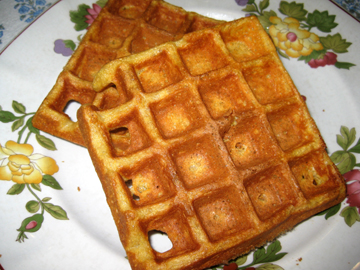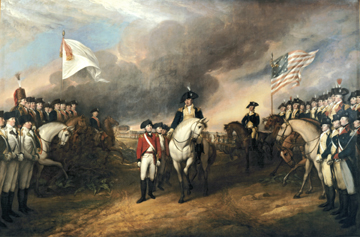
Today is Shrove Tuesday, a.k.a. Mardi Gras, a.k.a. Pancake Tuesday.
Pancakes are a traditional food on the day before Ash Wednesday since they contain several substances Christians traditionally gave up for Lent—milk, eggs, and butter.
My family has rechristened the day Waffle Tuesday so that we can eat our newest breakfast creation, Corn Waffles. We first made them last week to help my nephew Michael study for a test.
Michael lives in Virginia. Recently in school he has been studying Virginia’s past—specifically, the state’s part in the Revolutionary War.
The other day we were quizzing him on material he had been asked to learn.
He did a great job mimicking John Paul Jones and declaring, “I have not yet begun to fight.”
He knew where Thomas Jefferson lived even though we have yet to visit Monticello. (I hope we’ll get there in the spring!)
For some reason, however, he had trouble remembering details about the Battle of Yorktown—specifically, the name of the British General who surrendered at Yorktown to George Washington, Lord Cornwallis.
In order to make Cornwallis’s name more memorable we started calling him Lord Corn Waffles.
Soon we decided to reinforce the lesson by allowing Michael to taste the general’s namesake.
The rest, as they say, is history……

Corn Waffles
Ingredients:
1/4 cup (1/2 stick) sweet butter
1-1/4 cups flour
3/4 cup yellow cornmeal
1/2 teaspoon salt
1-1/2 teaspoons baking soda
1 cup buttermilk
3/4 cup milk
2 eggs, separated
2 tablespoons sugar
1-1/4 cups flour
3/4 cup yellow cornmeal
1/2 teaspoon salt
1-1/2 teaspoons baking soda
1 cup buttermilk
3/4 cup milk
2 eggs, separated
2 tablespoons sugar
Instructions:
Melt the butter and set it aside to cool slightly while you assemble the other ingredients.
In a medium bowl use a whisk to combine the flour, cornmeal, salt, and baking soda.
In a larger bowl combine the buttermilk, milk, and egg yolks. Stir in the dry ingredients.
In a clean bowl beat the egg whites until they hold soft peaks. Beat in the sugar. Gently fold the sugared egg whites into the milk combination.
Cover the batter and place it in the refrigerator overnight. (You may just let it stand at room temperature for a few minutes, but your waffles will be fluffier if the batter can stand overnight, and the cornmeal will be better blended.)
The next morning take the batter out of the refrigerator and let it stand at room temperature for 15 minutes.
Brush your waffle iron with butter and preheat it. Cook the waffles as needed (usually 3 to 5 minutes, depending on your waffle iron).
Serves 4 to 6.

The Surrender of Cornwallis by John Trumbull (Photo Credit: Architect of the Capitol)
If you enjoyed this post, please consider taking out an email subscription to my blog. Just click on the link below!
Subscribe to In Our Grandmothers’ Kitchens by Email.
Tags: Corn Waffles, Pancake Tuesday, Shrove Tuesday Recipes, Surrender at Yorktown
What a fun Auntie you are! I am definitely tucking this one away for some Sunday morning. We’re big waffle fans here and these sound hearty and delicious! Combined with some pastured pork breakfast sausage from Holiday Brook Farm…..YUM!
Tinky the waffles look yummy!! I think we just may have a Waffle dinner tonight… MMmmmmm 🙂 ps. Michael is getting so big…
Culinary mnemonic tricks have been used for a great long time in spurring the recollection of military accomplishments. But in fact, beyond their ability to jog one’s memory, the names of most pastries and baked goods originally derived from battles and skirmishes. What is curious is that in every instance, including the corn waffle of Cornwallis and Yorktown renown, the successful pastry was named after the unsuccessful military commander! Of course Waterloo is the most well known, having given rise to the Napoleon, but a lesser known general at that battle, a French commander by the name of Major General Jean-Louis Henri-Philippe Guy du l’Éclair also inspired a Parisian pastry chefs to new heights. In fact the Emperor was somewhat miffed that his general received the (ultimately) more popular concoction.
At Agincourt, Henry V was nearly defeated by Jean-Baptiste Marie-Francois, Duc de D’Eau-Nantes, whose round shields were distinguished by smaller holes made at the center through which soldiers might simultaneously protect themselves and still see the approaching foes. These shields were, of course, immortalized by London cooks who learned of them from returning English foot soldiers: the fried dough recipe, quickly assembled to feed the famished troops, was called Deaunante, and later, Doughnut.
Of course the prize for European militaristic pastry undoubtedly must go to the bombe. In the United States, the honor would no doubt be conferred upon the War of 1812 British general, Herkimer Browney, for whom the fudge-like cake was named when it’s first production appeared to have resulted in a disappointingly fallen cake. A contender in the military rout turned into culinary triumph might well be the aftermath of Little Big Horn, when late 19th-century Americans regularly presented dinner guests with a dessert of Egg Custer. Readers interested in pursuing this further would be well advised to look to Bartholomew Biddle’s “Atop the Firing Range” which documents untold foods (mainly pastries) and their genealogy in military history. Outside of the field of baking, the best known is naturally Chicken Marengo, while neophytes (in history) are often misled by General Tso’s Chicken.
I love the photos in this blog article! If you look on the right side of the Surrender of Cornwallis photo, you can see my g-g-g-g-grandfather (something like that). But he is not on a horse; I think he’s watching from a distance. You can barely make him out in the background, I think. 🙂 You are on a roll with many good postings!
Looks lovely! someone here is always agitating for waffles, but the waffle iron is as old as I am, so I am a bit suspicious of it . . .
Please come and make breakfast for me!!
ps – the sandwich was named after the Earl of Sandwich, who wanted to eat dinner while gambling – someone hit on the idea of putting his dinner between two slices of bread!!
Thank you, everyone; they were indeed delicious. E., I am jealous of your genealogy. And Peter, I’m jealous of your “research” skills. Happy Mardi, Gras……….